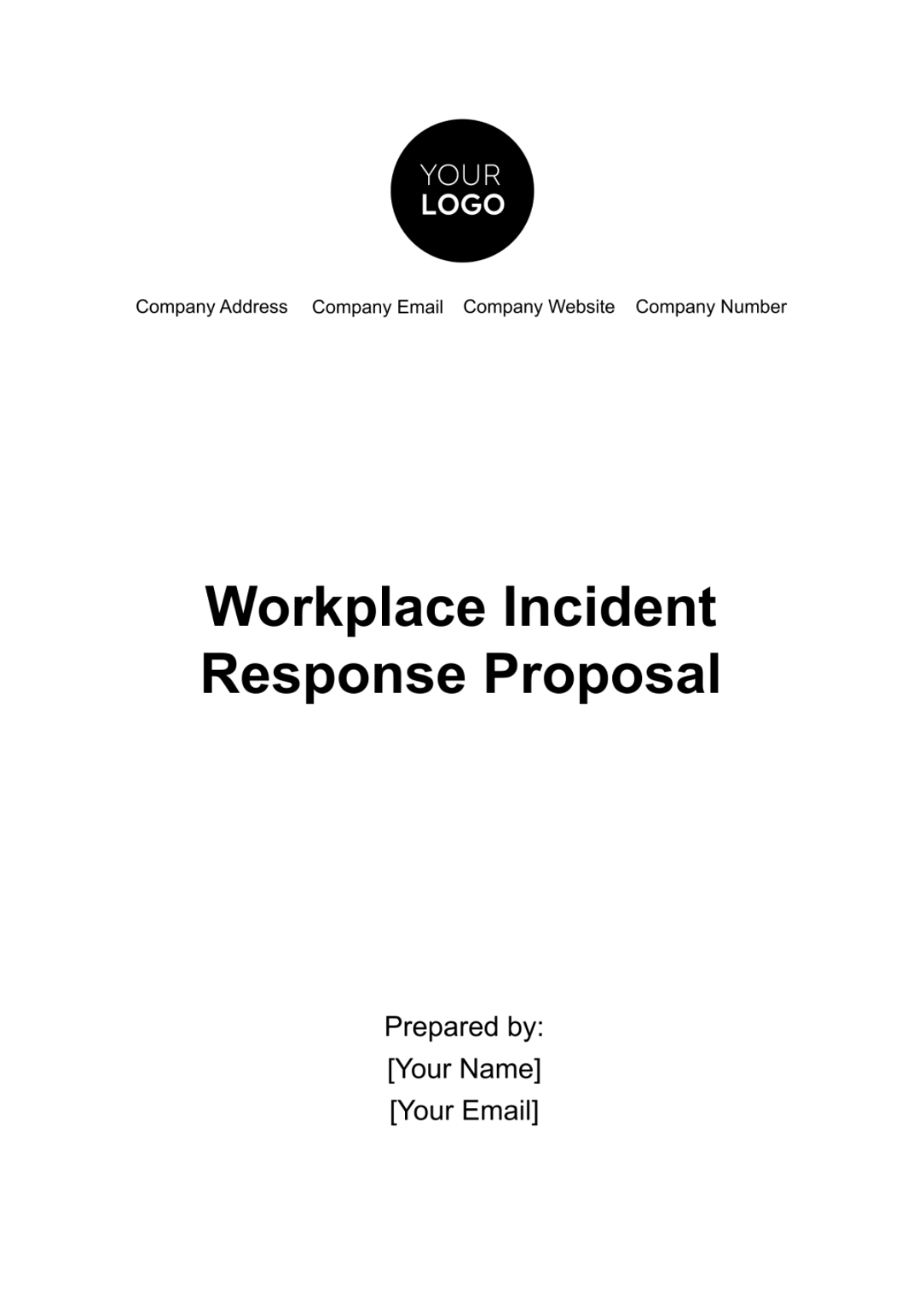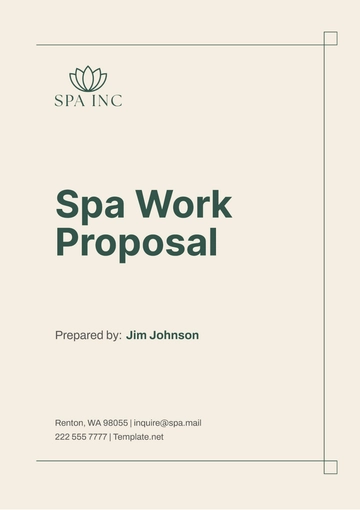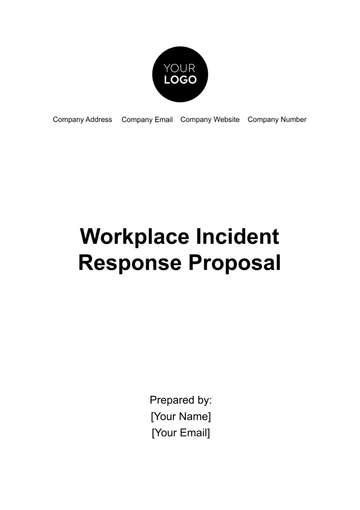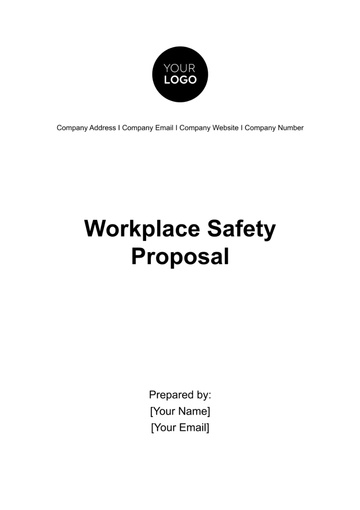Free Workplace Incident Response Proposal

I. Introduction and Objectives
Purpose of the Proposal: The primary aim of this proposal is to develop a well-structured and effective framework for responding to workplace incidents. This framework prioritizes the safety and well-being of [Your Company Name]’s employees, ensures adherence to all relevant legal and regulatory standards, and aims to mitigate operational disruptions. By establishing clear protocols and procedures, the proposal seeks to equip the organization with the tools and knowledge necessary to manage incidents efficiently and effectively. |
The core goals of this proposal are multi-faceted: A. It aims to enable a prompt and effective response to incidents, ensuring immediate risks are managed swiftly to protect personnel and property; B. The proposal focuses on ensuring strict compliance with legal and regulatory frameworks, thus safeguarding the organization against potential liabilities and legal complications; C. It aims to minimize the impact of incidents on business operations, thereby maintaining business continuity during and in the aftermath of incidents; and D. It seeks to foster a culture of safety and preparedness within the organization, enhancing the overall resilience against unforeseen events. |
The scope of this incident response plan is comprehensive, encompassing a wide array of potential incidents that could occur in the workplace. This includes but is not limited to, common workplace injuries, equipment and machinery failures, fire outbreaks, and security breaches such as unauthorized access or data theft. The proposal outlines specific guidelines for the management and response to each of these incident types, considering the unique challenges and requirements they present. The plan is designed to be adaptable and scalable, suitable for incidents of varying magnitudes and natures. |
II. Incident Response Team and Structure
This section outlines the organizational structure for incident response, emphasizing the importance of having a dedicated team with clearly defined roles and a well-established communication hierarchy. It also addresses the need for team availability, ensuring round-the-clock readiness.
A. Team Composition
The Incident Response Team will comprise a Safety Officer, HR Representative, Legal Advisor, Communications Specialist, and relevant Department Heads. Each member has defined roles and responsibilities in managing different aspects of the incident.
Role | Responsibilities | Member Name/Position |
Safety Officer | Lead incident response efforts, coordinate on-site actions | [Name/Title of Safety Officer] |
HR Representative | Address well-being, coordinate support services | [Name/Title of HR Rep] |
Legal Advisor | Provide legal counsel, manage compliance issues | [Name/Title of Legal Advisor] |
Communications Specialist | Handle internal and external communications, media liaison | [Name/Title of Comms Specialist] |
Department Heads | Oversee department-specific responses, resource allocation | [Names/Titles of Dept Heads] |
B. Communication Hierarchy
Establish a clear chain of command for reporting and decision-making during an incident. The Safety Officer acts as the primary coordinator, with the HR Representative managing employee-related issues and the Communications Specialist handling internal and external communications.
Level | Role | Communication Responsibility |
1 | Safety Officer | Primary incident coordinator, decision-maker |
2 | HR Representative | Employee-related communications, assistance coordination |
3 | Legal Advisor | Legal and compliance advisories, external authority liaison |
4 | Communications Specialist | Internal updates, media and public communications |
5 | Department Heads | Departmental response coordination, resource management |
C. Team Availability
Ensure that team members are available and reachable at all times. Implement an on-call rotation system to cover non-working hours and holidays.
Role | Work Hours | On-call Hours | Notes/ Comments |
Safety Officer | 9 am - 5 pm | Rotational | On-call during weekends and holidays |
HR Representative | 9 am - 5 pm | Rotational | Available for employee support after hours |
Legal Advisor | 9 am - 5 pm | As needed | Contactable for urgent legal matters |
Communications Specialist | 9 am - 5 pm | Rotational | Handles urgent communications outside regular hours |
Department Heads | Varied | Varied | Availability depends on departmental needs |
III. Incident Identification and Assessment
Precise incident identification and thorough assessment are crucial for an effective response. This section details the methodology for categorizing incidents and evaluating their impact, ensuring a systematic and measured response approach.
A. Identification Criteria
Define specific criteria for what constitutes an incident, including any injury to employees, significant property damage, or operational disruptions. Set thresholds for different levels of incidents based on severity and impact.
Incident Type | Criteria for Identification | Severity Level |
Employee Injury | Any physical injury to employees during work hours | Minor to Critical |
Property Damage | Significant damage to company property or equipment | Moderate to Severe |
Operational Disruption | Interruptions to normal operations, including system failures | Minor to Major |
Security Breach | Unauthorized access, data theft, or cyber incidents | Moderate to Critical |
B. Assessment Procedures
Implement a standardized procedure for assessing the incident's impact on safety, operations, and compliance. This includes an initial on-site assessment by the Safety Officer and further evaluation by the Incident Response Team.
Assessment Phase | Responsibility | Action Steps |
Initial On-Site Assessment | Safety Officer | Evaluate immediate safety risks, secure the scene, and provide an initial classification of the incident. |
Detailed Incident Analysis | Incident Response Team | Conduct a thorough analysis of the incident, including root cause analysis and impact assessment. |
Impact Evaluation | HR, Legal, and Operations Teams | Assess the impact on personnel, legal compliance, and business operations. |
C. Activation of Response Plan
Criteria for activating the incident response plan based on the initial assessment. This includes guidelines for when to escalate the incident to higher management and external authorities.
Incident Severity | Response Activation Level | Decision Authority |
Minor | Managed by department heads with notification to the safety officer | Department Heads |
Moderate | Coordinated response by the Incident Response Team | Safety Officer |
Major/Critical | Full activation of the Incident Response Plan, involving top management and external authorities | Top Management |
IV. Response Procedures
Effective incident management requires both immediate and strategic long-term responses. This section outlines comprehensive procedures to address incidents promptly and to manage their aftermath effectively, ensuring a coordinated and efficient approach.
A. Immediate Actions
Develop immediate response protocols for different types of incidents, such as securing the area, providing first aid, and notifying emergency services. Include procedures for evacuation, containment of hazards, and initial communication to employees.
Incident Type | Immediate Action Steps | Responsible Party |
Employee Injury | Provide first aid, secure the area, and call emergency services | First Aid Responders, Safety Officer |
Property Damage | Secure and isolate damaged areas, assess structural integrity | Safety Officer, Facilities Team |
Operational Disruption | Implement contingency plans, notify relevant departments | Department Heads, Operations Team |
Security Breach | Activate IT emergency protocols, inform security team | IT Department, Security Officer |
B. Long-term Response Strategies
Outline strategies for ongoing incident management, including resource allocation, continuous assessment of the situation, and coordination with external agencies if required.
Strategy Component | Description | Implementation Steps |
Resource Allocation | Distribute necessary resources for incident resolution | Identify resource needs, allocate as per urgency and impact |
Continuous Situation Assessment | Monitor the situation for any changes or escalations | Regular updates from response teams, ongoing risk assessments |
External Agency Coordination | Liaise with external agencies for support and compliance | Engage with authorities, external experts, and legal advisors |
C. Post-Incident Recovery
Plan for post-incident activities, including debriefing, return-to-normal operations, and support for affected employees.
Recovery Phase | Action Plan | Responsibility |
Debriefing and Analysis | Conduct a thorough review of the incident and response actions | Incident Response Team, Department Heads |
Return-to-Normal Operations | Gradually restore normal operations, address operational gaps | Operations Team, HR Department |
Employee Support | Provide counseling, medical follow-up, and other support services | HR Department, Employee Assistance Programs |
V. Training and Simulation
Regular training and simulation exercises are crucial for ensuring preparedness and effective implementation of the incident response plan. This section proposes plans for training programs and simulation drills.
A. Training Programs: Schedule regular training sessions for the Incident Response Team and employees on incident response protocols, first aid, evacuation procedures, and specific hazard awareness relevant to the workplace.
B. Simulation Exercises: Conduct semi-annual simulation exercises to test the effectiveness of the response procedures, identify areas for improvement, and ensure team readiness.
C. Feedback and Improvement: After each training and simulation exercise, gather feedback from participants and observers to continually refine and improve the incident response plan and procedures.
© [Year] [Your Company Name]. All Rights Reserved.
- 100% Customizable, free editor
- Access 1 Million+ Templates, photo’s & graphics
- Download or share as a template
- Click and replace photos, graphics, text, backgrounds
- Resize, crop, AI write & more
- Access advanced editor
Introducing Template.net's editable and customizable Workplace Incident Response Proposal Template. Craft comprehensive plans swiftly with our AI Editor Tool, ensuring readiness for unforeseen events. Tailor strategies to your organization's needs effortlessly, fostering a proactive safety culture. Prepare, mitigate, and respond effectively with this essential tool in your arsenal.
You may also like
- Business Proposal
- Research Proposal
- Proposal Request
- Project Proposal
- Grant Proposal
- Photography Proposal
- Job Proposal
- Budget Proposal
- Marketing Proposal
- Branding Proposal
- Advertising Proposal
- Sales Proposal
- Startup Proposal
- Event Proposal
- Creative Proposal
- Restaurant Proposal
- Blank Proposal
- One Page Proposal
- Proposal Report
- IT Proposal
- Non Profit Proposal
- Training Proposal
- Construction Proposal
- School Proposal
- Cleaning Proposal
- Contract Proposal
- HR Proposal
- Travel Agency Proposal
- Small Business Proposal
- Investment Proposal
- Bid Proposal
- Retail Business Proposal
- Sponsorship Proposal
- Academic Proposal
- Partnership Proposal
- Work Proposal
- Agency Proposal
- University Proposal
- Accounting Proposal
- Real Estate Proposal
- Hotel Proposal
- Product Proposal
- Advertising Agency Proposal
- Development Proposal
- Loan Proposal
- Website Proposal
- Nursing Home Proposal
- Financial Proposal
- Salon Proposal
- Freelancer Proposal
- Funding Proposal
- Work from Home Proposal
- Company Proposal
- Consulting Proposal
- Educational Proposal
- Construction Bid Proposal
- Interior Design Proposal
- New Product Proposal
- Sports Proposal
- Corporate Proposal
- Food Proposal
- Property Proposal
- Maintenance Proposal
- Purchase Proposal
- Rental Proposal
- Recruitment Proposal
- Social Media Proposal
- Travel Proposal
- Trip Proposal
- Software Proposal
- Conference Proposal
- Graphic Design Proposal
- Law Firm Proposal
- Medical Proposal
- Music Proposal
- Pricing Proposal
- SEO Proposal
- Strategy Proposal
- Technical Proposal
- Coaching Proposal
- Ecommerce Proposal
- Fundraising Proposal
- Landscaping Proposal
- Charity Proposal
- Contractor Proposal
- Exhibition Proposal
- Art Proposal
- Mobile Proposal
- Equipment Proposal
- Student Proposal
- Engineering Proposal
- Business Proposal






